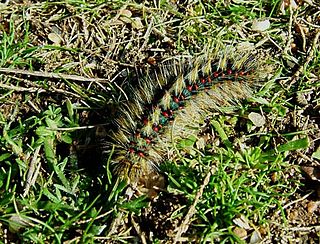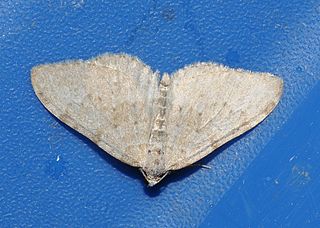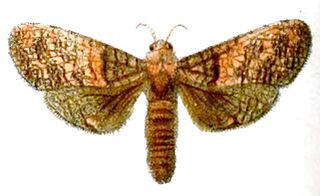Axia olga, the European gold moth, is a cimeliid moth found in Armenia and Russia. The species was first described by Otto Staudinger in 1899.

Axia, the gold moths, is a genus of moths whose precise relationships within the macrolepidoptera are currently uncertain, but they currently are placed within the superfamily Drepanoidea. Uniquely, they have a pair of pocket-like organs on the seventh abdominal spiracle of the adult moth which are possibly sound receptive organs. They are quite large and brightly coloured moths that occur only in southern Europe and feed on species of Euphorbia. Sometimes they are attracted to light. The genus was first described by Jacob Hübner in 1821.

Evergestis is a genus of moths of the family Crambidae described by Jacob Hübner in 1825. A number of species are pests, including the cross-striped cabbageworm, a pest of cole crops such as cabbage.
Antha is a genus of moths of the family Noctuidae. The genus was described by Staudinger in 1892.
Aventiola is a monotypic moth genus of the family Erebidae described by Staudinger in 1892. Its only species, Aventiola pusilla, was first described by Arthur Gardiner Butler in 1879. It is found in Japan and south-eastern Siberia.
Bryomoia is a monotypic moth genus of the family Noctuidae. Its only species, Bryomoia melachlora, is found in south-eastern Siberia, Korea, Japan and Taiwan. Both the genus and species were first described by Staudinger in 1892.

Cleonymia is a genus of moths of the family Noctuidae.

Dasypolia is a genus of moths of the family Noctuidae. The genus was erected by Achille Guenée in 1852.
Hepatica is a genus of moths of the family Noctuidae. The genus was described by Staudinger in 1892.
Plusilla is a monotypic moth genus of the family Noctuidae. Its only species, Plusilla rosalia, is found in south-east Siberia, Korea and Japan. Both the genus and species were first described by Staudinger in 1892.
Ocnerogyia is a monotypic moth genus in the subfamily Lymantriinae. Its only species, Ocnerogyia amanda, is found in Iran. Both the genus and the species were first described by Staudinger in 1892.

Chondrostega is a genus of moths in the family Lasiocampidae. The genus was erected by Julius Lederer in 1858.

Nebula is a genus of moths in the family Geometridae erected by Charles Théophile Bruand d'Uzelle in 1846.

Axia margarita is a moth of the family Cimeliidae first described by Jacob Hübner in 1813. It is found in Morocco, Spain, Portugal, southern France, Istria and southern Carniola.
Eremocossus vaulogeri is a species of moth of the family Cossidae. It is found in Senegal, Mauritania, Morocco, Algeria, Libya, Tunisia, Egypt, Jordan, Israel, Syria, Egypt, Oman, Yemen, the United Arab Emirates, Saudi Arabia, Iraq and southern Iran.
Axia napoleona is a species of moth of the family Cimeliidae first described by Schawerda in 1926. It is found on Corsica.
Axia nesiota is a species of moth of the family Cimeliidae first described by Hans Reisser in 1962. It is found on Crete and in mainland Greece.

Hypopta is a genus of moths in the family Cossidae.

Nordstromia grisearia is a moth in the family Drepanidae. It was described by Otto Staudinger in 1892. It is found in the Russian Far East, Japan and China.







